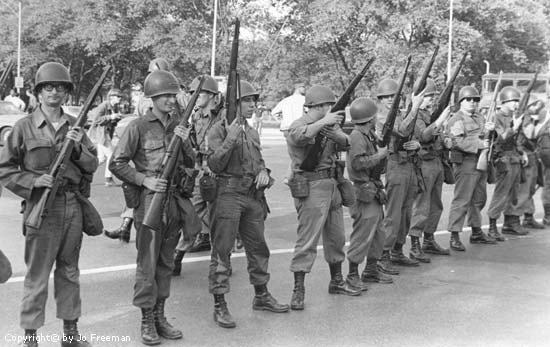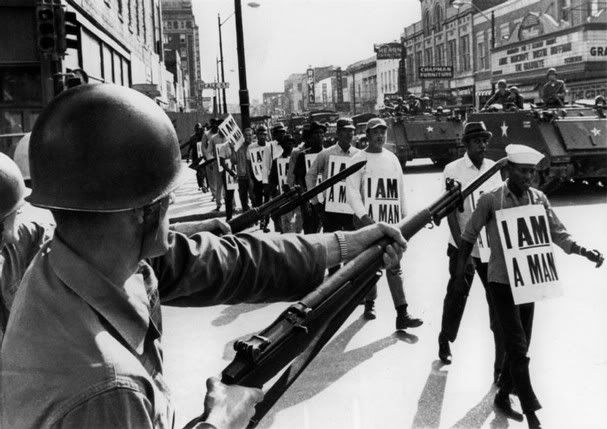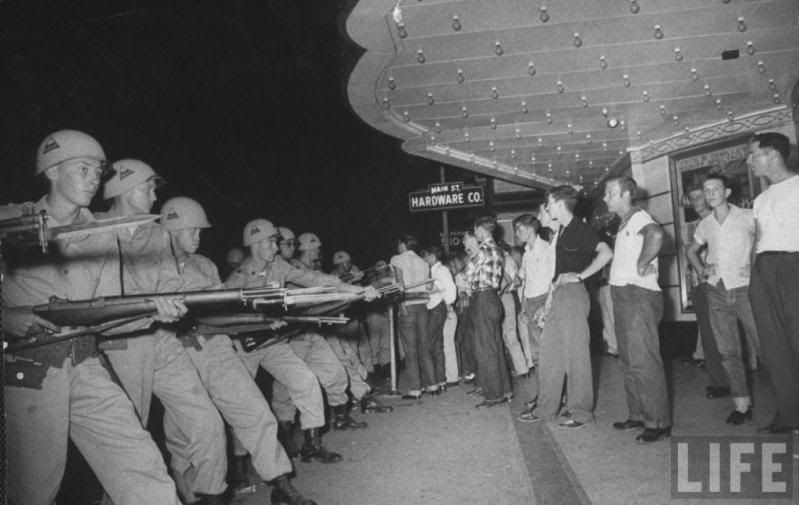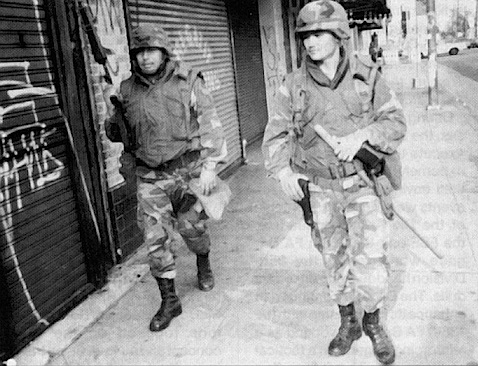I included a pictorial history of the use of troops domestically from the 1950s to the present day in order to remind people that the U.S. government is very willing to use troops against the American people. With the passage of NDAA and the post 9-11 national security environment, the creation of the Northern Command, the threat of military force against the people of the United States is all too real.
KZ
Northern Command Takes Command of Domestic Enforcement When the People Rise-Up
The practice harks back to the 1968 Democratic National Convention
By John Glaser
Antiwar.com, July 23, 2012
Antiwar.com, July 23, 2012
The US military will be on call to respond and use force in case of unrest at this year’s Democratic and Republican Party National Conventions in Tampa, Florida and Charlotte, North Carolina.


The National Guard aiding the Chicago police at the 1968 Democratic Convention
In a disturbing illustration of the creeping militarization of the day, US Northern Command has admitted that the Army will aid domestic law enforcement if called upon by the Secretary of Defense.
“During the Democratic/Republican National Conventions, Department of Defense personnel will support the U.S. Secret Service,” a Northern Command spokesman said in an email.
“For operational security reasons we do not discuss the numbers of military personnel and resources that are involved,” U.S. Navy Lt. Cdr. William G. Lewis said. “Additionally, we do not share our operational plans.”
Laws and traditions in this country going back hundreds of years have tried to restrict the government’s ability to use its military force on its own people, as a vital safeguard against outright militaristic rule here at home.The Bush administration’s post 9/11 attempts to cripple those safeguards still linger.
Northern Command took over responsibility for homeland security when Bush and the Department of Defense created the agency after the 9/11 attacks.

The practice harks back to the 1968 Democratic convention where a US Army and National Guard plan called Operation Garden Plot authorized an infantry brigade armed with riot control equipment and snipers to quell protesters if called upon.
“My job was to shoot to kill as directed,” said former US Army Cmd. Sgt. Maj. Gary Huber, who was assigned as a sniper in the Garden Plot. “I’m surprised we were issued ammunition because that normally wasn’t the case except when I was assigned along the East German border.”
At a time when the US military is peppered across the world, occupying foreigners in several countries, it’s perhaps unsurprising that the federal government and their professional militias also view American citizens as potential enemies to be dealt with by force.
Military stands ready if needed at political conventions
By TED JACKOVICS
Tampa Tribune via Stars and Stripes, July 23, 2012
TAMPA — Former U.S. Army Cmd. Sgt. Maj. Gary Huber was assigned to a Nike missile site defending Chicago against Soviet bombers when he first heard about Operation Garden Plot.
An intelligence agency believed the Students for a Democratic Society intended to disrupt the 1968 Democratic National Convention by seizing an Army installation along Chicago’s lakefront.

Troops wearing tear gas masks, Chicago, 1968
Nike Hercules missiles were equipped with nuclear warheads, and the federal government wasn’t taking any chances.
Government officials brought in an infantry brigade from Colorado and provided Chicago-area Nike personnel with riot control equipment and marksmanship training, said Huber, an electronics specialist whose primary Garden Plot assignment was as a sniper.
“My job was to shoot to kill as directed,” Huber said in a Skype interview from his Illinois home. “I’m surprised we were issued ammunition because that normally wasn’t the case except when I was assigned along the East German border.”
The 1968 Democratic convention was indeed riotous, but nobody took over the Army installation. More than four decades later, the idea that the military would be called in to help police a political convention seems drastic.

Troops interact with citizena, Chicago, 1968

That doesn’t mean plans aren’t still in place, though.
Over the past 44 years, Operation Garden Plot has evolved and been superseded by U.S. Northern Command plans created specifically for major public events — including the 2012 political conventions in Tampa and Charlotte.
“During the Democratic/Republican National Conventions, Department of Defense personnel will support the U.S. Secret Service,” a Northern Command spokesman said in an email.
“For operational security reasons we do not discuss the numbers of military personnel and resources that are involved,” U.S. Navy Lt. Cdr. William G. Lewis said. “Additionally, we do not share our operational plans.”

Troops in Washington, DC 1968
The secretary of defense would have to approve any request for military assistance, Lewis said.
Northern Command took over responsibility for homeland security when President George W. Bush and the Department of Defense created the agency after the 9/11 attacks. The agency refers to Operation Garden Plot as “an old Army plan that is no longer is in existence,” Lewis said.

Troops kill antiwar protesters at Kent State
Military publications have reported security officials have called upon aspects of Garden Plot plans and its Northern Command evolution at political conventions from 1968 through at least 2004.
“I would say that 9/11 increased the threat perception,” said John Pike, director of Global Security.org, who has been called to testify to Congress on military affairs. “People have been worried about al- Qaida jumping out of manhole covers.”

Troops in Memphis, 1968
Pike said he understands that the military must be prepared for a serious event at a political convention, even though as a Nixon-era anti-Vietnam war “street fighter” he sees that scenario as unlikely.
“I think the whole thing is pretty harmless,” said Pike, who said Garden Plot got its start from conflicts over civil rights and the Vietnam War. “But look at what’s being planned for the Olympics, with an aircraft carrier in east London.
“If anything goes wrong, you are asked, ‘Why didn’t you plan for this.’ If nothing happens, people will say ‘you overreacted.’ “

Troops in Newark, NJ 1967


The details of what Garden Plot evolved into are classified.But the original operation provides an indication of how the government in recent years planned for events in which the military would be called upon to support civilian security forces.
A 1968 copy of the Army’s Garden Plot originally classified as confidential categorized Tampa/St. Petersburg as an “intermediate priority” for Army planning.

Troops in Milwaukee, WI 1967


A section on “specifics during disturbances” cited “fire, looting, arson and numbers and types of people involved (i.e. juveniles, Negroes, Puerto Ricans).”
Indicators of potential violence included “high unemployment and increased crime rates among minority groups” and “protests by minority groups to such conditions as slum conditions, segregation in housing and schools, lack of jobs, lack of recreational facilities, police brutality and local overpricing practices.”

Troops in Detroit, 1967
Equipment and weapons to be issued to military involved in Operation Garden Plot included rifles, pistols, shotguns, M60 machine guns and grenade launchers.
Subsequent documents show Garden Plot was revised over the years and changed the way intelligence was to be gathered.
Northern Command’s creation resulted in Garden Plot successors, called concept of operations plans, for “Defense Support of Civil Authorities” and “Civil Disturbance Operations.”

Troops in Berkely, CA, 1969


Among case studies in a National Guard handbook is a synopsis of planning for the 2004 Republican National Convention in New York. It said Northern Command provided sophisticated communications equipment to provide a common operational picture of the convention.
“What would happen … if there were an incident at the Convention?” the case study said. “(The joint task force commander) could only guess because the contingencies were simply too many and varied.”
Huber, who was based at the Munster, Ind., Nike site south of Chicago in 1968, became involved in a typical military change of plans during the Democratic convention.

Troops in Clinton, TN 1956
At first, he said, he was called upon to evaluate the chemical, biological and radiological preparedness for an assault by Students for a Democratic Society assault on a Nike missile site along Lake Shore Drive, one of nine such sites encircling Chicago and Gary, Ind.
“We had been told the protestors planned to occupy the site at Jackson Park,” Huber said.

Los Angeles 1992
Launching a Nike missile required a complicated process to ensure security. But because the launcher area contained nuclear warheads, those areas were provided additional fencing and dog patrols at Nike sites nationwide.
“I do not know if the Army thought the SDS could launch a Nike Hercules, but some intelligence agency made the case there was intent by the SDS and a possibility of success,” Huber said.
Huber also coordinated operations between Nike personnel and soldiers from the 5th Infantry Division from Fort Carson, Colo., and prepared to become a sniper.

Los Angeles, 1965
“The primary purpose of the infantry brigade was to stand shoulder-by-shoulder on the inside of the exclusion (inner perimeter) fence of the launcher site,” Huber said.
“The 5th Infantry soldiers were to be used as a show of force. Others from the Nike sites had security assignments triggered by signals, alarms or voice announcements to report to a building, a rooftop, a radar mast or another security point depending upon the alerting signal.”
The Army took the Jackson Park site off operational alert, its missiles and warheads kept beyond sight in their underground magazines, and put Huber’s Nike site, 20 miles to the southeast, on “hot” status ready to launch a missile within 15 minutes.
The Jackson Park site reportedly remained secure, beyond the Chicago protestors’ confrontations with authorities. Huber rode out the convention at the Munster, Ind., Nike site, though not without a little excitement.
“A young person chose to penetrate the site through a hole in the bottom of a fence the Army had temporarily filled with some concrete blocks,” Huber recalled. “He immediately met one of our German shepherd security dogs and got hauled away.”
